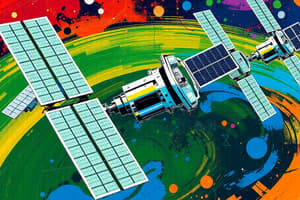Podcast
Questions and Answers
What is the primary difference between geostationary satellites and polar-orbiting satellites?
What is the primary difference between geostationary satellites and polar-orbiting satellites?
Geostationary satellites remain above the same spot on Earth, while polar-orbiting satellites travel from pole to pole, scanning the entire planet.
How do agencies prevent satellite collisions in space?
How do agencies prevent satellite collisions in space?
Agencies like NASA track satellites and launch them into orbits designed to avoid collisions.
What information do satellites that monitor Earth provide to scientists?
What information do satellites that monitor Earth provide to scientists?
They provide data about clouds, oceans, land, ice, atmospheric gases, and energy balance, aiding in weather and climate predictions.
What role do satellites have in responding to natural disasters?
What role do satellites have in responding to natural disasters?
What are some tasks performed by satellites that observe space?
What are some tasks performed by satellites that observe space?
What defines a natural satellite?
What defines a natural satellite?
How do satellites enhance communication compared to traditional methods?
How do satellites enhance communication compared to traditional methods?
What are the two essential components most satellites share?
What are the two essential components most satellites share?
Describe how satellites collect data about Earth.
Describe how satellites collect data about Earth.
In what way do satellites provide an advantage over ground-based telescopes?
In what way do satellites provide an advantage over ground-based telescopes?
Explain the role of gravity in a satellite's orbit around Earth.
Explain the role of gravity in a satellite's orbit around Earth.
What types of images do satellites capture to assist scientists?
What types of images do satellites capture to assist scientists?
How do solar panels function on satellites?
How do solar panels function on satellites?
Flashcards are hidden until you start studying
Study Notes
Definition of a Satellite
- A satellite can be a natural body, like a moon or planet, or a man-made machine that orbits a celestial body.
- Earth and the moon are examples of natural satellites; Earth orbits the sun and the moon orbits Earth.
Types of Satellites
- Natural Satellites: Moons and planets orbiting larger celestial bodies.
- Man-made Satellites: Thousands of devices launched into space for various purposes, including weather observation, scientific research, and communication.
Importance of Satellites
- Satellites provide extensive data from a large area of Earth, surpassing the capabilities of ground-based instruments.
- They enhance observations of space by avoiding atmospheric interference from clouds and dust.
- Before satellites, TV and phone signals had limited range and could be blocked by terrain.
How Satellites Facilitate Communication
- Satellites enable the transmission of TV signals and phone calls by sending signals upward and redirecting them back down to Earth.
- This technology overcomes geographical obstacles that complicate traditional communication methods.
Key Components of Satellites
- Common components include an antenna for communication and a power source, which can be solar panels or batteries.
- Many satellites are equipped with cameras and sensors to collect data about Earth and space.
Satellite Orbits
- Satellites are launched using rockets and achieve orbit by balancing speed with Earth's gravitational pull.
- Two main types of orbits include:
- Geostationary Orbit: Satellites move at the same rotational speed as the Earth, appearing stationary above a specific point.
- Polar Orbit: Satellites travel north to south, scanning the Earth in strips as it rotates beneath them.
Collision Risks and Tracking
- Satellites can collide, but such incidents are rare due to careful tracking and orbit design to avoid others.
- The first recorded accidental collision between two man-made satellites occurred in February 2009, involving one American and one Russian satellite.
Current Uses of Satellites
- Satellites aid scientific research by monitoring clouds, oceans, land, and ice, as well as measuring atmospheric gases and energy flux.
- Vital for weather prediction, climate study, tracking natural disasters, and assessing public health and agriculture.
- Space-focused satellites monitor solar activity and explore the cosmos, including studying planetary features and formations.
Studying That Suits You
Use AI to generate personalized quizzes and flashcards to suit your learning preferences.




